Question: In the right wing crusade to ban books that portray American society as inherently racist and that promote the LGBTQ agenda, the Bible has also been caught up in the net of books removed from school libraries for review. In Utah a school district actually removed the Bible from elementary and middle schools for being violent and explicitly sexual, although it was allowed to remain in high school libraries. When pressed, school officials responded that the Bible was not a book for young readers, that it’s not part of the curriculum, and parents can teach it to their children at home. Do you think these officials have a point?
Frank answers: It seems that folks from both the left and the right have called into question whether it is appropriate to have the Bible in school libraries. That in itself could be an argument for why the Bible should be accessible. People will want to see what all the fuss is about by reading the Bible for themselves, if they haven’t already. In fact, the crusade against including certain books in the curriculum and in the school library has undoubtedly had the effect of creating a desire among middle and high school students to read these books for themselves. Remember that when God told Adam and Eve not to eat the fruit of the tree of the knowledge of good and evil in the middle of the Garden of Eden, it didn’t take much talking from the snake to convince Eve to sample its taste and to share it with Adam. Making something forbidden always whets our appetite to taste it.
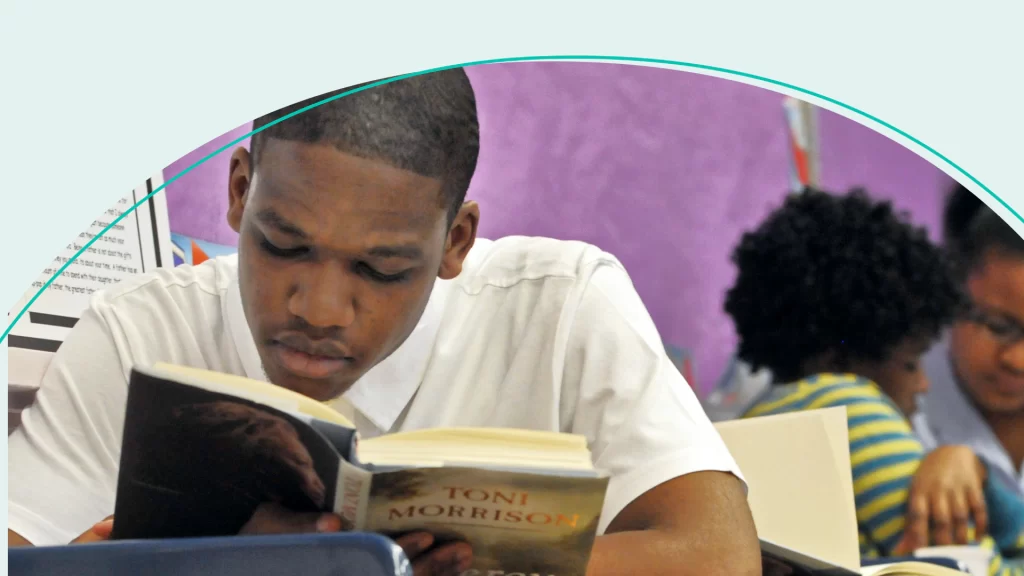
There has always been pressure to ban books–and even burn them! Book banning in school libraries has increased in the last few years. PEN America, a free speech organization, has found more than 4,300 books banned in 23 states at the opening of the fall term in 2023. The number of banned books may be undercounted because PEN gets it figures from new reports. The rise in book banning has been at the instigation of conservative groups in both Republican and Democrat school districts. Many of the titles deal with LGBTQ characters or race and racism issues. This has included the removal even of dictionaries and encyclopedias. The most number of banned books has been in Florida because of its confusing curriculum laws. In some instances teachers and librarians are just trying follow the new laws.
When the Moms for Liberty group succeeded in getting five books removed from the Tallahassee, Florida high school, the Freedom from Religion Foundation, which describes itself as a nontheistic nonprofit, gave the Leon County School District an ultimatum: Ban the Bible or stop banning books altogether. The Freedom From Religion Foundation, which is committed to the separation of state and church, has said that all versions of the Bible should be purged from school libraries using the same criteria by which other books are banned. It asserted that the Bible is full of verses that “display a lewd, depraved, pornographic view of sex and women, with sexual violence often ordered or countenanced by the biblical deity.” This is not appropriate material for children.
I think the person in Utah who called for the Bible to be banned from school libraries assumed that school boards would never go along with banning the Bible in that conservative state, but pointed out that if all explicitly sexual material is to be banned from schools, the Bible is full of it. “Incest, onanism, bestiality, prostitution, genital mutilation, fellatio, dildos, rape, and even infanticide,” the parent wrote in their request, listing topics they found concerning in the religious text. “You’ll no doubt find that the Bible, under Utah Code Ann. § 76-10-12 27, has ‘no serious values for minors’ because it’s pornographic by our new definition.”
This parent was probably surprised when the Davis County School District officials actually removed copies of the Bible they had on their shelves in elementary and middle school libraries, noting that the Bible was never part of students’ curricula. The Bible has since been restored even to elementary and middle school libraries in that school district by a review committee.
You are correct that the Bible has been caught up in the nationwide book-banning dragnet. This happened in the Escambra County Public Schools in Florida, the Keller Independent School District in Texas, the Wentzville School District in Missouri, and the Academy 20 District in Colorado Springs. Because of accusations of the Bible’s explicit and inappropriate sexual and violent content, copies were removed from Academy 20’s library for review purposes. They were reshelved when the committee decided that the Bible should not be banned.
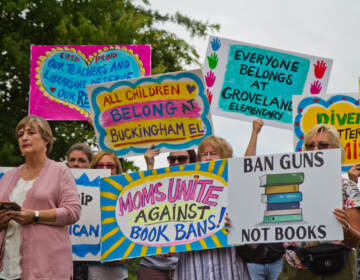
Violence in the Bible
As far as violence in the Bible is concerned, most of the stories are well known. Cain kills his brother Abel out of jealousy already in Genesis 4. The flood that saved Noah and his family and all those animals in the ark drowned the rest of humanity. With Earth wiped clean, creation could begin anew. The firstborn sons in Egypt died if they hadn’t smeared the blood of a lamb on their doorposts and lintels when the angel of death passed over. Then there were Pharaoh’s charioteers and horses that drowned in the returning waters of the Red Sea after the Israelites made it safely to the other side. The Holy Wars in which the Israelites took possession of the promised land, land that was already occupied by Canaanites in the interior and Philistines along the coast, was accompanied by terrible slaughter. The commanding general was, in effect, the Lord God of Israel who gave commands to commanders of the armies of Israel in the field. The land was to be purged of idols and idolators.
The story of the Israelite superhero Samson is well known. In his battles against the Philistines he was able to slay an entire army with the jaw bone of an ass. To find out the secret of his amazing strength the Philistines dispatched the beautiful Delilah to seduce him into sharing his secret, which was the Nazirite vow he had made to let his hair grow long with seven locks. She got him drunk with wine and loosened his tongue to divulge his secret and when he fell asleep she summoned a man to cut his locks and other collaborators to put him in chains and lead him away. She was paid well for her betrayal. The Philistines gouged out his eyes and made him work like an ox walking his circles pushing a wheat grinding stone. At a feast in the Temple of Dagon they led him out and chained him to pillars of the Temple on public display. He asked God for one more feat of strength and succeeded in pushing apart the pillars of the temple, bringing down the house of the pagan deity and killing many of Dagon’s worshipers. (The story is more complicated than this brief synopsis and can be read in Judges 13 — 16.)

In another story of going against the Philistines, the young shepherd boy David went one-on-one with the giant Philistine warrior Goliath and felled him with a direct hit to his forehead with a stone shot from his sling shot. Then the young hero cut off Goliath’s head as a trophy for King Saul. Here’s how the Italian painter Caravaggio portrayed it. Gory? You bet!
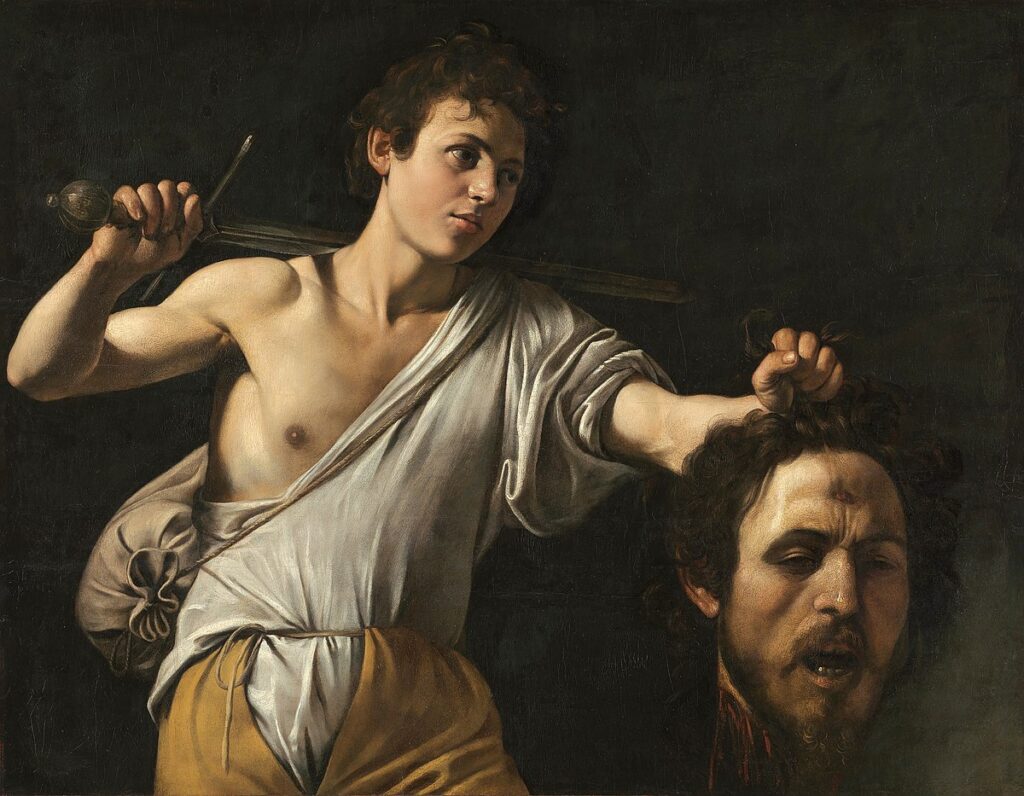
Of course, the central story of the New Testament is the atoning sacrifice of Christ on the cross. When the religious leaders presented Jesus to the Roman governor, Pontius Pilate, for execution because he claimed to be a messianic king, Pilate tried to placate them by having Jesus flogged to within an inch of his life. Then when he was presented to the mob as a candidate for release on the Feast of Passover in competition with the bandit Barabbas, the crowd stirred up by the religious leaders shouted “Crucify him!”, giving into the mob. Jesus was led away to be nailed up on a post with a cross beam and left to hang there—naked!—to die. It was all very violent and these stories are pictorially retold in Children’s Bibles that are read at home and in Sunday School classes.

Explicit Sex in the Bible
What about the Bible’s explicit sex? When I led a Bible study in my church, and we finished reading through the Book of Genesis, a man in the class exclaimed, “This book is all about sex!” Yes it is. But the begetting was somewhat irregular by our standards of mongamy. Abraham got tired of waiting to have the promised offspring by Sarah and produced a son (Ishmael) by the servant woman Hagar. The twelve sons of Jacob, who was renamed Israel because of his struggles with God, were born from the two daughters of Laban whom Jacob married, Leah and Rachel, and their serving women Bilhah and Zilpah. Lot’s daughters despaired over having descendants for their father after their escape from Sodom and while they were living in a cave the oldest daughter got her father drunk and had sex with him. The next night the second daughter did the same. Both became pregnant and from this double incest Moab and Amman were born (Genesis 19:30–38).
Polygamy was practiced by the patriarchs and the kings. David was married to Michal, the daughter of King Saul, as well as Ahinoam of Jezreel and Abigale. But when he saw Bathsheba bathing on her rooftop (a rite of purification), he sent for her. She was married to Uriah the Hittite, but David seduced her and she became pregnant. David arranged for her husband Uriah to be placed in the thick of a battle and be killed. The Lord condemned David’s actions through the words of Nathan the Prophet. The child born from this adulterous affair died. But from the marital union of David and Bathsheba, Solomon was born who would succeed David as king and have an immense harem.
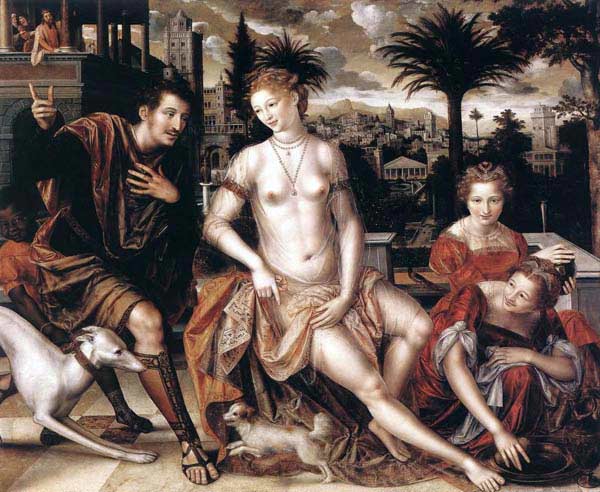
Homosexuality
Of course, the sexuality that the conservative book-banners are most concerned about is homosexuality. The books that promote the LGBTQ agenda, like Laia Kobabe’s Gender Queer, Juno Dawson’s This Book is Gay, and Toni Morrison’s The Bluest Eye, are on the banned list because they regard the teaching of these texts as an effort to groom children and youth. To groom them for what? To become gay? You can groom students to become racists or white supremacists or Christian nationalists, but you can’t groom children to become gay. They are either attracted to the same sex or they are not. You can, however, groom them to become homophobic and attack gays. This boy in the UK was beaten for being gay. It happens in the U.S. too.

Where did homosexuality come from? It is a term coined by the late 19th century German psychiatrist Richard von Krafft-Ebing to refer to an inherent same-sex attraction. Before this there were same-sex behaviors, but after the condition of homosexuality was defined (and regarded as a disease) it behooved heterosexual men to stay clear of homosexuals lest these perverts come onto them. Whereas in earlier times men showed affection to a male friend and even shared a bed (as Abraham Lincoln did with several men), after the definition of homosexuality, intimacy with another male became something for men to avoid. You didn’t want to be called a “homo.” In 1895 the German journalist Max Nordau published a popular book, Degeneration, in which he blamed the decline of the West on homosexuality and sexual perversions. These views led to new anti-sodomy laws and raids on gay bars and the baring of effeminate men from teaching jobs. The recent success of LGBTQ rights and same-sex marriage has brought about a homophobic reaction. The book-banning crusade is part of it.
Homosexuality in the Bible
“The sin that may not be named” was sodomy, named after the city of Sodom. In Genesis 19, two angels disguised as men come to Sodom to check up on its reputation of wickedness. Lot offers them hospitality. The men of Sodom want to “know” these men and bang on Lot’s door to send them out. The word “know” from the Hebrew yada can refer to sexual intercourse. Lot understood this as the men’s intention (a gang rape) and offered his virgins daughters instead. These men were not homosexual, as it has been defined in modern times, because Lot thought their lust would be satisfied by raping his daughters. But whatever their intention, the men of Sodom never got to “know” the strangers in Lot’s house because the angels blinded them. Nevertheless, the name “Sodom” has been applied to a sexual act that never took place, but especially male-on-male anal sex. Anti-sodomitic laws could also be applied to heterosexual sex, but usually weren’t.
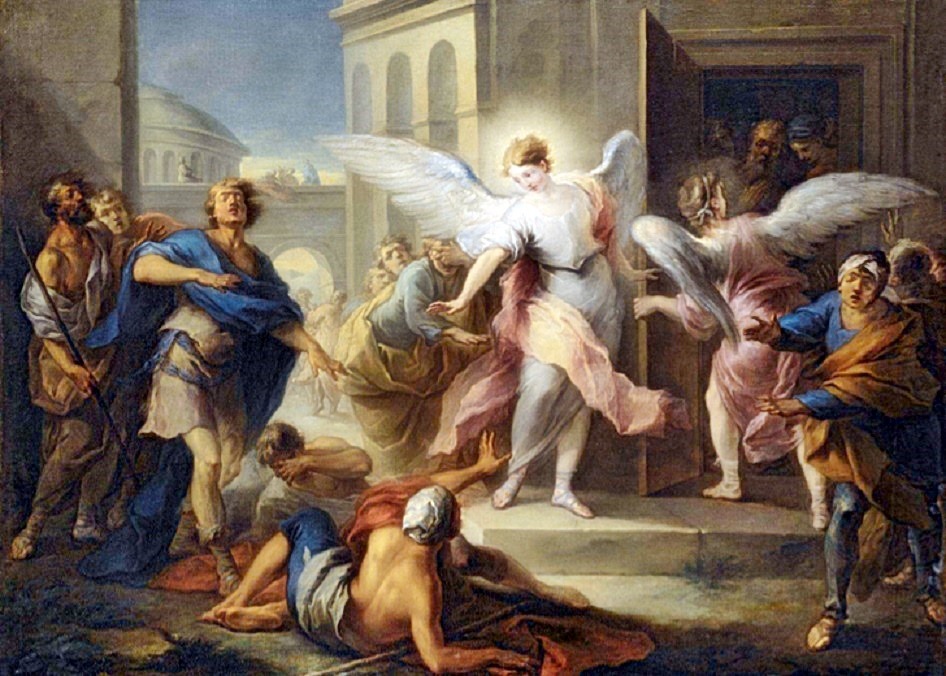
The angels given hospitality by Lot blind the men of Sodom so Lot and his family could escape the city before God rained down fire to consume it. Lot’s family was told not to look back, but Lot’s wife did and she was turned into a pillar of stone.
We know of texts in the Bible that condemn male-on-male sex. Conservatives appeal to these texts. But we shouldn’t read our own cultural assumptions into scriptural texts. Scripture should interpret scripture. Leviticus 18:22 says it is “an abomination” for a male to lie with a male as he would lie with a woman.” But over the entire holiness code is the Lord’s instruction that the Israelites should not do in the land of Egypt as the Egyptians did and “you shall not do as they do in the land of Canaan, to which I am bringing you” (Leviticus 18:3). What do the Canaanites do that the Israelites should not do? They practice sacred prostitution. We know from later books that the young men of Israel did hire themselves out for prostitution in pagan temples. They employed themselves in the service of these pagan gods. They supported idolatry. That’s the “abomination.”
Sacred prostitution also flourished in the temple of Aphrodite in Corinth, along with the general prostitution that flourished in this port city. St. Paul has a discussion of prostitution in 1 Corinthians 6:12–19. In 6:9 he has a catalogue of those who shall not inherit the kingdom of God that includes “fornicators, idolaters, adulterers, male prostitutes, sodomites,” etc. (NRSV translation). Paul actually used two Greek terms that are hard to find equivalents for in English: malakos and arsenokoitos. The King James Version translated them as “effeminate” and “abusers of themselves with mankind.” The two terms implied what gay sex regards as bottoms and tops: the penetrator and the one penetrated. Prostitution (porne – the root of “pornography”) could refer either to temple prostitution or to on the streets prostitution. That was the issue in I Corinthians.
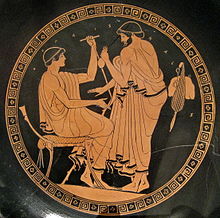
Male-on-male sex in ancient Greece involved older men having sex with young men. The figures on Greek vases shows an older man (with a beard) bargaining for sex from a beardless youth. Pederasty was well known in Ancient Greece. Plato had a long discussion about man-boy love in his Symposium. That book would defiinitely be on the banned list in schools today. The above vase etching might represent temple prostitution and the following shows a man bargaining with a street prostitute.
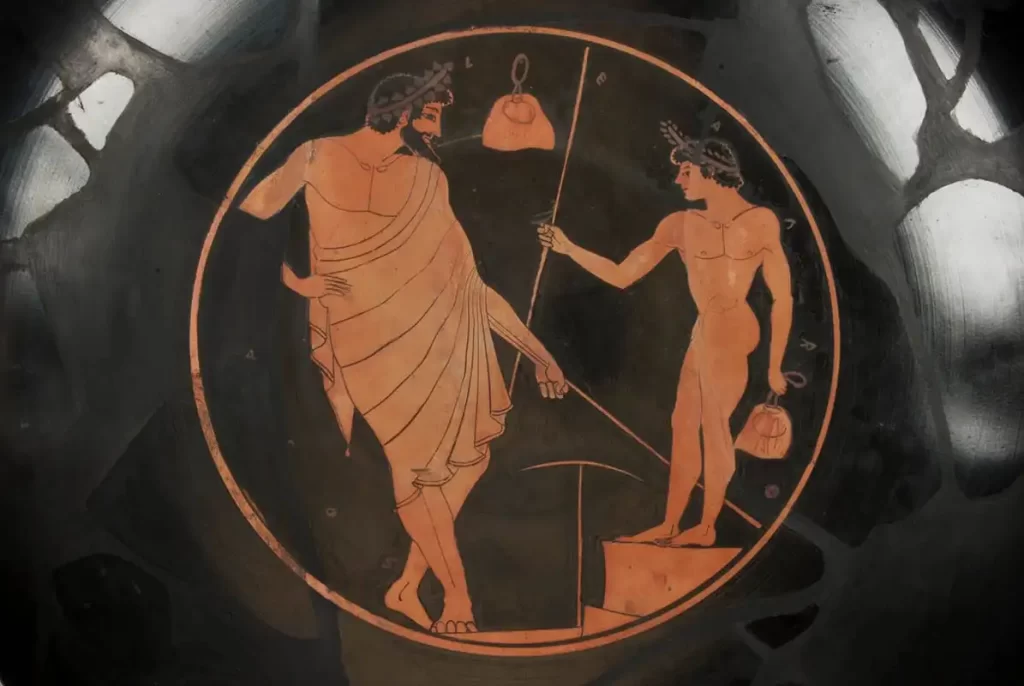
The words St. Paul used in 1 Corinthians 6:9 can’t be translated as “homosexual.” First, the term and concept wasn’t known back then and, second, because the Greek term that comes closest to what we would translate as “queer” or “gay” was kinaidos. The kinaidoi were known for their flamboyant life styles and dress (sometimes wearing women’s clothes). Their antics were portrayed in Greek plays and were discussed by philosophers, but St. Paul nowhere used the term. The German painter Anselm Feuerbach tried to capture the partying kinaidoi in this painting of 1871–74. Here are the queers of ancient Greece. The point of bringing up this term and life style here is precisely because it wasn’t referred to by St. Paul, even though the antics of the kinadoi were well known. The Bible does not discuss homosexuality as we know it, only prostitution, particularly cultic, and those whom we call heterosexuals acting contrary to their nature.

Same-sex Intimacy
Not all same-sex relationships are condemned in the Bible. One example is the friendship between David and Saul’s son Jonathan. Two scenes seem especially homoerotic. One is when Jonathan strips himself of his sword, shield, and princely robe and gives them to David.
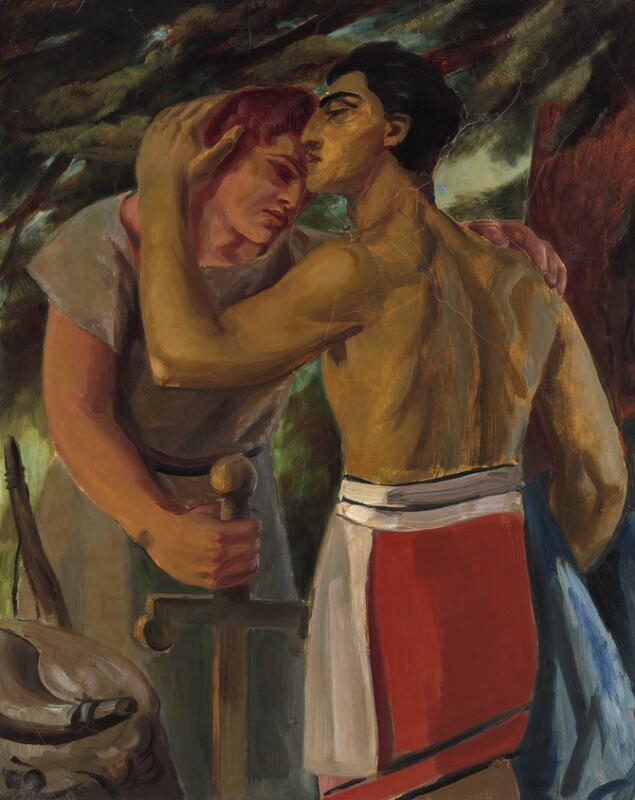
Another is when Jonathan seeks out David, who is hiding out of fear of Saul’s intention to kill him, and they greet each other with a hug and a kiss.

A third scene is when David mourns the death of Jonathan.
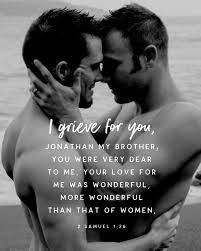
We cannot know whether David’s love for Jonathan, which he regarded as “more wonderful than that of women” (2 Samual 1:26), meant that they had had a sexual relationship. However their relationship was expressed, it was not condemned in the Bible.
As for Jesus himself, he often visited his friends Mary, Martha, and Lazarus of Bethany. When Lazarus died Jesus came to the tomb (too late, the sisters thought) and wept. Some of the Jews commented, “See how he loved him” (John 11:35–36). Jesus performed his greatest miracle by raising his friend Lazarus from the dead.

There was a “beloved disciple” among the twelve (referred to six times in the Gospel of John), who reclined on Jesus’ breast at the last supper (John 13:23–25). This “disciple whom Jesus loved” has been identified in the tradition as John the brother of James. In church art, both in paintings and woodcuts, he has been portrayed as inclining his head on Jesus’ breast. At the foot of the cross Jesus commends his mother to this disciple’s care (John 19:26–27).
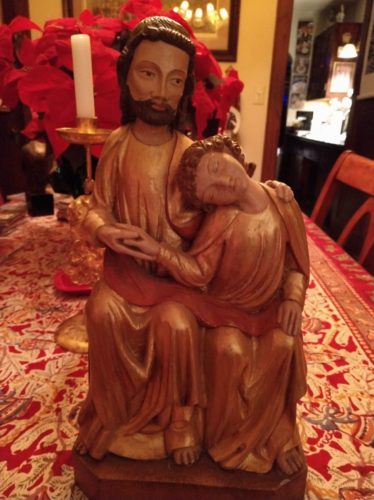
Let me take up one more category: whoring. Hosea used the example of going after his wayward wife to bring her back home as an illustration of the Lord’s steadfast love for Israel in spite of his people turning to other gods. Ezekiel used the example of whoring in chapters 20 and 23 as an allegory of Israel seeking alliances with Egypt against the Babylonians instead of trusting in the Lord their God.
So, how shall I respond to your question? The Bible is full of stories that are not easily understood BY ADULTS, much less children. Yet the Christian community teaches the Bible to CHILDREN as well as to adults. How many great pieces of literature, beginning, say, with Homer’s The Illiad and The Odyssey, are easily understood? Homer’s epics are also replete with sex and violence and tangled human relationships. In fact, the campaign that had begun to restore the heterosexual union of Menelaus with Helen turned on the passionate homoerotic relationship between the two heroes Achilles and Patroclus. Patroclus’ death at the hands of Hector drew Achilles back into the war. In revenge Achilles killed Hector and dragged Hector’s naked body behind his chariot back to the Greek camp where he proceeded to mutilate it for another eleven days. Note: the relationship between Achilles and Patroclus is ambiguous in The Iliad, but later writers (Plato in the Symposion, Aeschylus, even Shakespeare in Troilus and Cressida) assume they were lovers. Well, they were fictional characters to begin with, only loosely based on historical figures, so later writers were at liberty to portray them as they saw fit. But considering the sexuality issues and brutality, all these classics would probably also be removed from the high school curriculum and the school libraries to prevent high school students from getting into a classroom discussion about whether these heroes were gay.
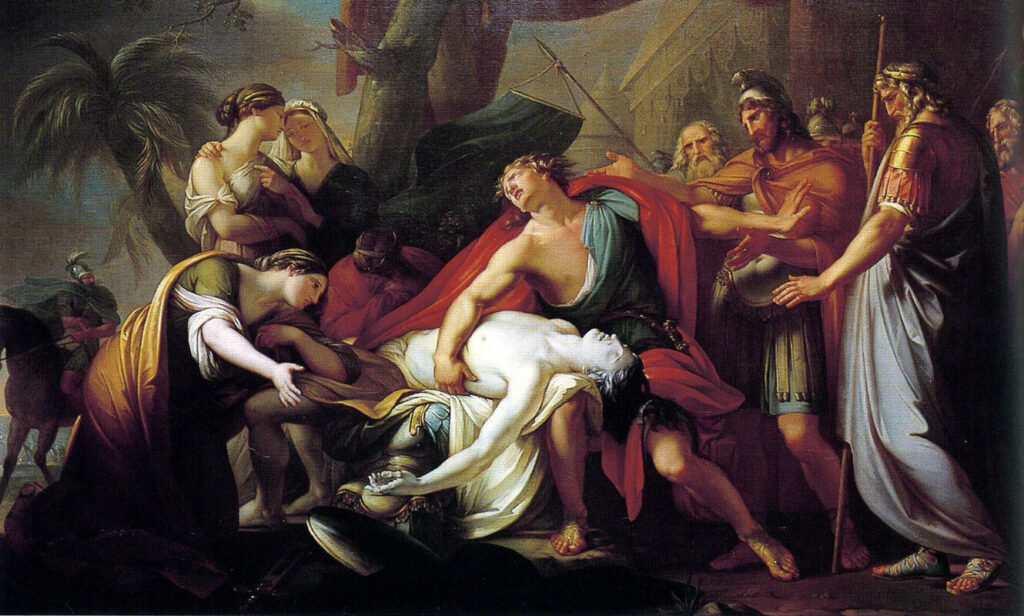
I once heard a lecture by W. W. Robson at Oxford University on John Milton. He began by saying that you couldn’t understand Milton or many of the great Western writers without a knowledge of the Bible and Homer. You don’t have to be a believer to find it valuable to know the Jewish and Christian Scriptures. The Bible is a foundational scripture for our civilization.
Obviously, there are many parts of the Bible that are more edifying than these texts of violence and sex. But there are also stories, like David and Jonathan, about the mutual commitments of brotherly love. How appropriate this story would be for boys who often form lasting relationships with buddies already in elementary and middle school, as well as in high school and college. Girls are not left out. There’s the touching story of the bond between Ruth and her mother-in-law Naomi. “Where you go I will go.”
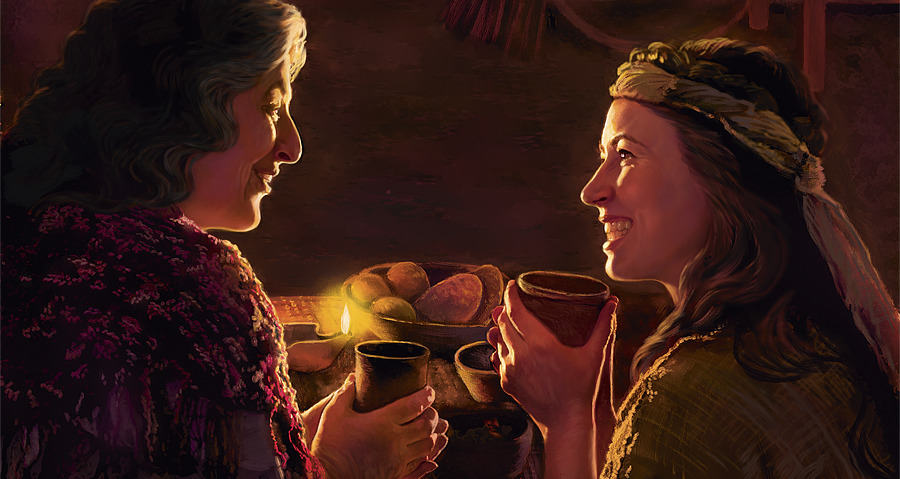
In Summary
I believe the Bible and other scriptures in our pluralistic society should be available in our school libraries. I believe further that the reading of sacred scriptures should be a part of our school curricula. Our students, especially in the elementary grades, should be taught the stories and rituals practiced by religious people in our society and read the relevant scriptural texts for Jewish, Christian, Islamic, Hindu, etc. holy days. Middle school students would be capable of getting more deeply into some of the biblical stories as well as teachings from other religions. I k now, because for years I taught 7th and 8th grade confirmands.
I think when high school students study various forms of literature, they should also study how sacred scriptures came together. In literature classes students should study how scriptures, novels, poetry, etc., present an understanding of reality that is complimentary to the views of the natural, social, and behavioral sciences. Human beings have both right and left brains. Our understanding of reality is based on experience as well as mathematical abstractions. What the Bible talks about is real life as we experience it, it’s often messy and violent and sexual; yet the Bible and other sacred books also have visions of a more perfect world. With help from experts in providing curricular materials, teachers can do this teaching.
Don’t exclude parents from these studies. Invite them into the classrooms to discuss what their scriptures mean to them. Give them a chance to recommend books for the school libraries rather than just voting to remove books. We can never have too many books, especially books that challenge our worldviews.
Pastor Frank
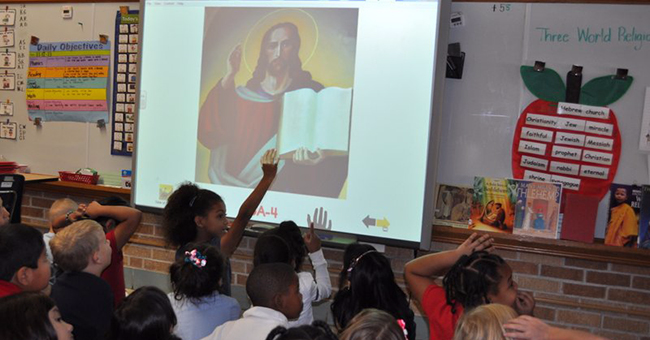

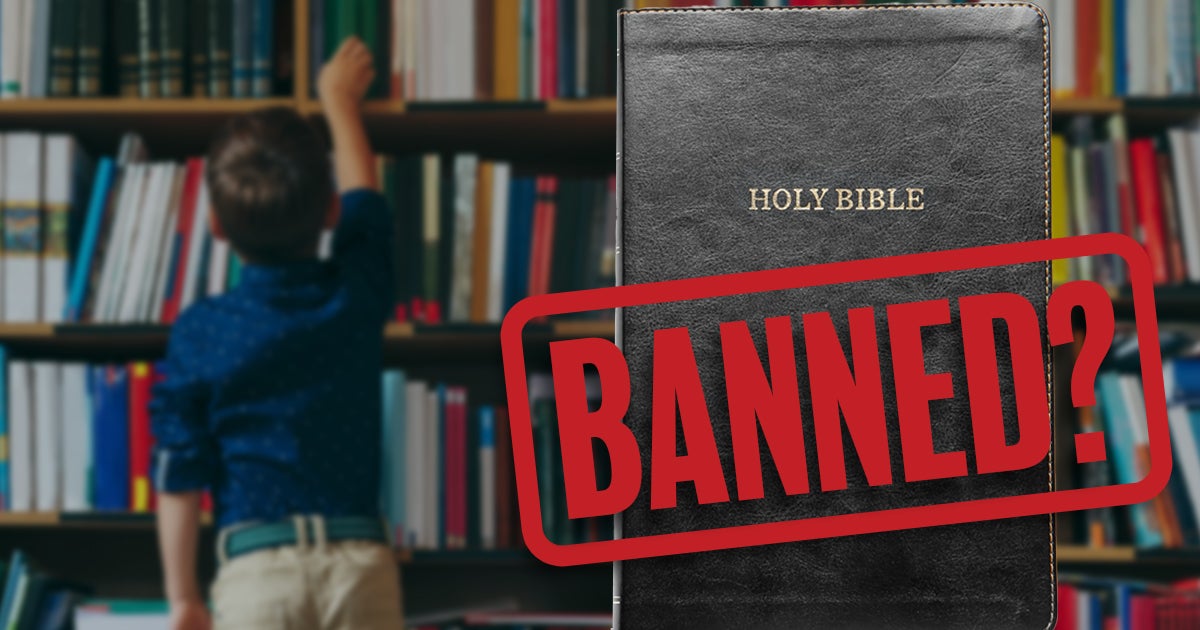
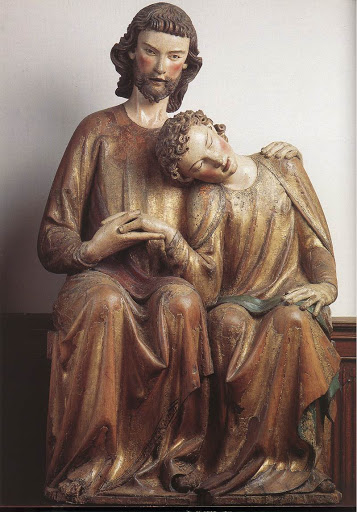



Very interesting piece. You look at this with open eyes!